| Research Achievements |
|||
|---|---|---|---|
| Theme: Vulnerability studies of Island ecosystem and adaptive strategies to develop climate resilient agriculture |
|||
| I.Validating the perceptions of tribal and non-tribal farmersabout climate change |
|||
| The long term temperature and rainfall data of Port Blair has been analysed to explore the occurrence of climate change as perceived by the non-tribal farmers of Andaman Islands. |
|||
| Change in summer temperature from January to April |
|||
| The trend of temperature parameters during the summer months ie. January to April has revealed that, the maximum temperature increased significantly from 28.6oC to 30.2oC in January, from 29.3oC to 30.6oC in February, and from 31.9oC to 32.6oC in April and insignificantly from 30.4oC to 31.4oC in March. On the other hand, the minimum temperature has increased significantly during all the summer months from 21.7oC to 23.4oC in January, from 18.6oC to 23.6oC in February, from 20.6oC to 24.2oC in March and from 24.3oC to 25.3oC in April |
|||
| Change in South-West Monsoon rainfall from June to September |
|||
| The trend of South-West Monsoon rainfall from June to September has revealed that, rainfall increased significantly from 669 mm to 691 mm in June, from 389 mm to 584 mm in August and from 306 mm to 404 mm in September; and decreased significantly from 427 mm to 383 mm in July |
|||
| Change in North-East Monsoon rainfall from October to December |
|||
| The trend of North-East Monsoon rainfall from October to December has revealed that, rainfall increased significantly from 352 mm to 462 mm in October and from 277 mm to 303 mm in November; and decreased significantly from 281 mm to 163 mm in December |
|||
| IÌ.Adaptation potential of dyke vegetable cultivation to overcome the impact of climate change on island agriculture |
|||
| Despite located in high rainfall zone, the Islands suffer moisture stress and poor crop harvest due to the erratic nature of rainfall and intermittent dry spells during monsoon; and water shortage and crop failure during summer. A study has been undertaken in Ferrargunj Tehsil of South Andaman district where varieties of vegetables are intensively cultivated throughout the year for the Port Blair market. During summer months, farmers cultivate cucurbitaceous and other climbing crops on the dykes in such a way that their vines train on trellis constructed across the drainage trenches. |
|||
| The 2 to 5 m wide trenches running across the farm are the modified or elongated gullies formed due to heavy runoff during monsoon season. These trenches are covered by erecting trellis using nylon ropes length and breadth wise (Figure 1). These nylon ropes are bound on the wooden stumps fixed along the bank of the trench in zig-zag manner. Climbing vegetable crops viz. ridge gourd, bitter gourd, bottle gourd, pumpkin, snake gourd, cucumber, broad bean, wing bean, cluster bean, long bean are planted on the edge of the dyke and allowed to climb on the trellis and spread above the trench. Farmers deliberately leave the dyke bare and not cultivate any crop till the water availability in the trench is enough to meet the water demand for those crops (Figure 2). Initially, the crops grown above the trench rely upon the residual moisture available in the dyke and later get irrigated from the water available in the trench. |
|||
| This strategy increases the land use efficiency, saves water in the trench from evaporation, provides ambient environment for the fishes in the trench, and reduces the irrigation requirement of crops. |
|||
| III. Climate resilience of CIARI technologies and impact study |
|||
| Noni (Morinda citrifolia L.) var. CIARI Sampada |
|||
| Study on the economics of climate resilient technologies revealed that Noni, a small tree of varied therapeutic values shows extremely wide range of environmental tolerances making it an invaluable component in various agroforestry systems aimed at climate change adaptation. |
|||
| In 2006-07, CIARI promoted Noni cultivation across Andaman & Nicobar Islands for avocation in challenged areas after Tsunami 2004. |
|||
| In 2007-08, through technology backstopping of the Institute, M/s. Andaman Plantations & Development Corporation Pvt. Ltd. a Kolkata based firm went for mass planting of Noni in 44 acres (17.8 ha) at different locations of South Andaman viz. 35 acres at Mithakhari, 8 acres at Minnie Bay and 1 acre at Bambooflat as intercrop in arecanut and coconut, all in rolling terrain and sloped hilly lands. |
|||
| Though the economic yield started by the third year after planting, the firm could not find any prospective buyer till 2011-12 when it sold 3 tons of fruits to a Vadodara based processing company @ Rs.160/kg (Rs.140 for packaging and transportation + Rs.20 for fruit). Over the years, its sales destinations expanded to Chennai, Noida and Delhi @ 5 t/year. |
|||
| Sensing the loss of market due to exorbitant freight cost involved in transporting the bulky consignments of fresh fruits to mainland, the firm established a Noni processing plant of 3t/day capacity at Mithakhari in 2016-17 through its sister concern M/s. Alberta Agro Pvt. Ltd. and since then selling Noni as processed material to mainland for further value addition. |
|||
| As a low input-high value crop, Noni is an ideal choice for alternate/additional source of income from marginal lands. At a commercial scale, an organic Noni plantation of 14 ha with 10,000 trees amidst arecanut attracts an initial investment of Rs.24.00 lakh/annum for first 3 years. Thereupon, Rs.14.40 lakh and Rs.1.50 lakh are incurred annually towards operational cost and FYM application respectively. The economic yield starts from the 4th year with 20-30 kg fruits/tree/annum, selling of which to the nearby processing unit at the rate of Rs.20/kg fetches a gross income of Rs.4.00-6.00 lakh/annum. At the end of 10th year, the plantation incurs an undiscounted expenditure and gross income of Rs.1.83 crore and Rs.3.40 crore respectively. When discounted at the rate of 12% per annum, the same amounts to Rs.1.09 crore and Rs.1.52 crore respectively with a B-C ratio of 1.39. |
|||
| In 10 years, an organic Noni plantation of 14 ha with 10,000 trees amidst arecanut incurs a discounted expenditure and income of Rs.1.09 crore and Rs.1.52 crore respectively fetching a BC ratio of 1.39. As a low input-high value crop, Noni is found to be an ideal choice for alternate/additional source of income from marginal lands. |
|||
| CIARI rice varieties |
|||
| 515 Kharif Technological Demonstrations and 423 Rabi Technological Demonstrations have been conducted covering 156.89 ha across 118 cluster villages and 47.05 ha across 123 cluster villages, respectively in North & Middle Andaman and South Andaman districts. |
|||
| The climate resilience of improved paddy varieties promoted/developed by CIARI was studied among 50 randomly selected farmers in Diglipur tehsil of North & Middle Andaman district and found that 52% cultivate only Gayatri variety of paddy. |
|||
| In addition to Gayatri, 12% farmers cultivate Jaya, 8% Jaganath, 4% Jaya and Jaganath, 12% CIARI 7, 2% Jaya and DRR 42; and 2% MTU 1010. |
|||
| Further, 2% farmers cultivate only Jaya and Jaganath, 4% Jaganath and 2% Lal Sona. 72% of farmers perceived that Gayatri withstands prolonged submergence during incessant rains, 64% felt that it has no lodging tendency thanks to strong stem (16%) and dwarfness (15%) which result in higher yield (42%). 38%, 24% and 10% of farmers felt that the variety attracts comparatively less pest, disease and weed incidence respectively, its late maturity helps to escape the untimely rains during the harvest season in September-October (35%). |
|||
| While the variety demands no fertilizer (12%), it produces long tillers (8%). |
|||
| A comparative economic analysis between improved and traditional paddy varieties shows that, Gayatri earns a net income of Rs.28,725/ha with B-C ratio of 1.48, while Jaya earns only Rs.8,580/ha with B-C ratio of 1.14 due to increased expenditure on one hand and reduced yield on the other. |
|||
| Non-availability of seeds on time is the foremost constraint to adopt improved paddy varieties followed by non-awareness about available improve varieties, non-availability of seeds in enough quantities. |
|||
| As most part of the produce is retained for household consumption, the taste preference of family members towards traditional varieties viz. Jaya and Jaganath and their suitability for specific traditional recipes deters them from pursue improved varieties. |
|||
| Modified Broad Bed & Furrow System of cultivation for challenged areas |
|||
| Shri Sudhir Dutta, a farmer in Creekabad village was earning a net income of Rs.12,000 to 15,000/ha by practicing a single crop of rice in his degraded land affected by Tsunami 2004. He was in search of technological intervention wherein he could cultivate and earn income to meet and enhance the livelihood of his family. |
|||
| The Scientific team inspected the farm during 2017-18 and analyzed its cropping pattern, resource base, soil quality etc. and found the soil to be highly acidic due to sulphate content. Under NABARD funded project, an intervention was made wherein a farm plan has been formulated with a modified Broad Bed Furrow System of 1188 sq.m. comprising 2 beds and a furrow in-between as below: |
|||
| As the farmer preferred brinjal which fetches good price in the market, seeds of high yielding variety of brinjal were provided to him for planting on the beds and suggested to apply poultry manure as soil amendment. |
|||
| The Scientific team inspected the farm during 2017-18 and analyzed its cropping pattern, resource base, soil quality etc. and found the soil to be highly acidic due to sulphate content. Under NABARD funded project, an intervention was made wherein a farm plan has been formulated with a modified Broad Bed Furrow System of 1188 sq.m. comprising 2 beds and a furrow in-between. |
|||
| III. Impact of mini incubator on the livelihood of rural populace |
|||
|
Under Bio-tech Kisan Hub project, mini-egg incubators of 240 egg capacity have been installed at the residence of three Farmer Fellow Ambassadors (FFA) viz. Smt. Joshna at Nayagaon, Smt. Meenakshi at Indira Nagar and Smt. Binita Singh at New Wandoor. A survey has been undertaken to assess the utilitization of the incubators in accordance with the objectives of the project. |
|||
| The FFAs are highly motivated to develop poultry farming on a commercial scale. |
|||
| The incubators are properly maintained in operational mode. |
|||
| They meticulously collect eggs from the neighbourhood and even from distant places; and provide hatching service for country fowl and duck to farmers; and Quail to CIARI at remunerative price. |
|||
| The hatching efficiency of incubators is 90-93%. |
|||
| FFAs are earning handsomely from a) hatching services @ Rs.7 to 20/egg, b) sale of chicks @ Rs.50 for 1day old, Rs.100 for 15 days old, Rs.120 for 1 month old and on weight basis thereafter. |
|||
| FFAs expressed the need to increase the capacity of incubator in future to meet the overwhelming demand for hatching from the neighbourhood. |
|||
They are maintaining records but not in a scientific way. Hence it is felt necessary to impart a training programme for FFAs on scientific bookkeeping which is essential:
|
|||
| Theme: Transfer of technology, capacity building, policy support and market intelligence to stakeholders |
|||
| Enhancing Nicobari tribal farmer's income through technological intervention |
|||
|
The impact of customized technological intervention on the income, livelihood and dietary pattern of tribal households of Car Nicobar Island was studied in collaboration with KVK, Nicobar. |
|||
| The KVK has adopted a Nicobari tribal farmer in 2016-17 who was practicing traditional tuhet system of subsistence farming and guided him with technological know-how and do-how of vegetable cultivation. |
|||
| In a span of 4 years, the farmer has brought 4,550 m2 of his hitherto fallow land of 2 ha under vegetable cultivation. |
|||
| By incorporating 8 to 15 vegetable crops, the diversification index of the farm increased from 0.58 to 0.77. |
|||
| Even as the acreage under high value vegetables increased, he simultaneously accommodated other crops in minor proportions to tide over production and marketing risks. |
|||
| Thus, through area expansion, technological adoption, diversified cropping pattern, efficient resource management and tactical marketing, the farmer’s gross income has increased 5.5 times from Rs.93,561 to Rs.5,15,935 while the net income has increased almost 12 times from Rs.36,711 to Rs.4,28,872. |
|||
| The study emphasizes the importance of Institutional support in increasing the vegetable production; and income and livelihood of the tribal farmers in far flung regions of these Islands. |
|||

Director, CIARI visiting the Noni plantation at ATIC |
|||
| Poultry entrepreneurship for income and livelihood enhancement |
|||
| Shri R. Raja, 37 years old B.A. graduate is the resident of Maccapahad village, South Andaman. Between 2002 and 2010, he participated in various training programmes inclusive of poultry farming conducted by KVK, South Andaman. In 2005, he joined Railway Protection Special Force as Constable, but resigned in 2007 due to family circumstances. Till 2010, he used to collect coconuts and arecanuts in and around his village for merchants on commission basis. |
|||
| In 2010, he started a poultry farm in an abandoned shed at his backyard with 500 Vanaraja birds under the technical guidance of KVK, South Andaman and sold to inter-Island ship caterers. In 2012, he availed a loan of ₹8.00 lakh from State Bank of India, Garacharma branch based on the project proposal prepared by KVK, South Andaman and started broiler farming with a sales capacity of 1,000 birds per month. Subsequently, he expanded his farm to the present sales capacity of 30,000 to 40,000 birds per month by availing loan from different banks. |
|||
| Initially, he used to purchase chicks from M/s. Shivani Poultry, Dollygunj @ ₹ 15/- and then from Chennai. Till 2016, he struggled to penetrate the market which was dominated by a single firm. In 2019, he started M/s. Amman Hatchery with two Incubators of 15,000 egg capacity each by availing a loan of Rs.40.00 lakh from Andaman & Nicobar State Cooperative Bank, Port Blair. This move helped him to reduce the expenditure on buying chicks; and to stabilize the production and marketing. Now, he is purchasing eggs from a firm at Bengaluru. With the moral support of his brother, he overcame the market threats and managed to establish a network with 38 shops in Port Blair to hold a market share of 20%. |
|||
| He has employed 15 staff for various operations and making a turnover of ₹52 lakh to ₹70 lakh per month from the sale of 30,000 to 40,000 birds at the wholesale rate of Rs.175/-. Soaring price of feed comprising soybean and maize, which have to be purchased from mainland is a major constraint faced by him as it shares around 65% of production cost. Even as he aims to start his own parent stock production in the long run to stop his dependence on others for eggs, his short term goal is to increase his market share from 20% to 25% by establishing another incubator of 15,000 egg capacity. Shri R. Raja’s story exemplifies the importance of Institutional support and credit in entrepreneurship development of aspiring youth in the Islands. |
|||
| Diversified farming to overcome challenged conditions |
|||
| Shri A. Samsuddin, aged 54 is an enterprising farmer of Ograbraj village, South Andaman. He runs a 3,000 bird capacity broiler farm; rears 100 desi poultry; rears 60 goats; collects, processes and supplies coconut to copra units; supplies 10 to 15 tonnes of noni fruits annually to the nearby processing plant from the 1,000 trees grown along the bunds and borders of his farm; raising different varieties of banana as intercrop in arecanut; and cultivates pepper using noni trees as standard |
|||
| Since 1995, he is participating in various capacity building programmes of KVK, South Andaman. In 2000, he started a broiler farm with 1,000 bird capacity under the technical guidance of KVK, South Andaman on buy-back agreement with M/s. RSN. Between 2008 and 2017, he discontinued the commercial scale broiler farming due to rate inconsistency with M/s. RSN, but maintained a subsistence stock. In 2017, he established a 3,000 bird capacity poultry farm with 700 birds per batch. While he sources out chicks from different hatcheries viz. M/s. Sai Poultry at Dhanikadi, M/s. RSN and M/s. Amman Hatchary at Maccapahad, he has established a consistent marketing network with shops in the locality and adjacent islands. |
|||
| Upon spending Rs.280 which includes Rs.60 on purchase of chick, Rs.175 on feed, Rs.20 on saw dust flooring and Rs.25 on maintenance, a bird achieves 1.8 kg weight by 45 days. By selling a bird at the wholesale rate of Rs.175 per kg, he earns a profit of Rs.20 per kg which translates into Rs.25,200 per batch of 700 birds in 45 days. Inspired by CIARI’s promotion of Noni for marginal lands in the Islands, he has been growing 1,000 trees of Noni var. CIARI Sampada since 2008 on the bunds and borders of his farm. Since past three years, the trees are bearing 10-15 tonnes of fruits per annum which he sells to the nearby processing plant of M/s. Alberta Agro Pvt. Ltd. at the rate of Rs.20/kg. With an expenditure of Rs.8 over DAP and FYM, he earns a profit of Rs.12/kg of fruit which translates into Rs.1.2 to 1.8 lakh per annum. |
|||
| He received Best Farmer Award from CIARI during the Island Kisan Mela 2015 and Best Banana Farmer Award from ICAR-NRC for Banana, Tiruchirapalli, Tamil Nadu during its 27th Foundation Day & Kisan Mela held on 21st August 2020. He swears farming the best among all professions both in terms of income it generates and the interesting challenges it poses. In this light, he advocates Integrated Farming System for its effective utilization of farm resources. |
|||
| Coconut entrepreneurship: A policy brief |
|||
| A survey conducted among participants of one-day EDP on coconut value addition has revealed that non-availability of labour for cultural operations as major constraint to farmers while lack of supportive policies/schemes, prospective markets and advanced machinery as the major hindrance to processing industry. As many of them wish to venture into the production of Virgin Coconut Oil, copra and neera & sugar products, they expect various institutional supportviz. simplified credit procedures and supportive policies. From their suggestions, it has been inferred that location specific processing technologies has to be disseminated considering the resources, infrastructure and market opportunities, market intelligence and quality standards need to be strengthened, organic production of coconut should be projected to get higher price for coconut products of Andaman & Nicobar Islands, drudgery reducing and processing equipment should be introduced to strengthen on-farm and community level processing; and clusters should be formed at community level to strengthen product branding and marketing. |
|||
| Fish Catch mobile app on agricultural information sharing and knowledge generation |
|||
| A&N Fish catch mobile app has been developed to collect the real time commercially important marine fish catch data from landing centre. User authentication login page has been developed to allow registered users to login to the site and update the catch data. The app has the ability to collect species-wise and gear-wise daily catch landed at landing centre. Important fish categories landing in A & N Islands are pelagic (seer fishes, coastal tunas, barracudas, anchovies, sardines, wolf herrings, mackerels, carangids, ribbon fishes etc.), demersal (silver bellies, elasmobranchs, perches, pomfrets, threadfin breams, croakers, gerrids, goat fishes, grunts, drift fishes, lizard fishes, flat fishes, bulls eye, cephalopods, shrimps, crabs, lobsters etc.), oceanic fisheries (yellowfin tuna, skipjack tuna, bigeye tuna), and bill Fishes (marlins, sail fishes, sword fish, wahoo, dolphin fishes, oceanic squids etc.). Major gears under usage are ring seine, gillnet, hand line, long line, and trawl net. |
|||
| Images and main features of 35 commercially important fish species belonging to pelagic, demersal and oceanic groups are available in the app for identification. This mobile application has been developed based on 3 Tr Architecture. Apache web services are configured and most popular Open Source license database management system MySql has been used in this application. The app has been integrated with web server and MySql data base server to store and retrieve data in real time. A&N Fish App has been published in Google Play store and Institute’s website. The App has been installed in boat owners’ mobile phones and demonstrated its functionalities. The advantages of this app are to get near real-time data, which will be stored in centralised server. It allows us to save time and collect data quickly and efficiently, leading to fisheries management and policy decision. |
|||
| Value chain of vegetable: Problems and Prospects at North Andaman |
|||
| Study on the problems and prospects of vegetable value chain in Diglipur market area revealed that 78% of farmers dispose their produce at wholesaler while 14% supply to retailer and 8% sell directly at Diglipur farmers’ market. |
|||
| Cauliflower, cabbage, vegetable cowpea, brinjal, bhendi, chilli, knolkhol and beans are the major vegetables sent to Port Blair. With regard to input market, seeds, organic fertilizers and pesticides are purchased from the private dealers at Diglipur. |
|||
| The major constraints in the input market are - delayed supply of seeds by Agriculture Department, spurious seeds of private dealers, unreliable organic fertilizers available at private dealers, exorbitant price of pesticides and lack of Institutional advisories for pest management. |
|||
| The major constraints in the output market are – highly volatile price of vegetables, price manipulation by traders and lack of bargaining power due to perishability of the vegetables. |
|||
| The findings of the survey were validated through Focus Group Discussion with 60 vegetable farmers of Madhupur and surrounding villages. |
|||
| Technological Demonstrations under National Extension Programme of IARI, New Delhi |
|||
| Palak var. Pusa All Green Under the National Extension Programme of IARI, New Delhi various vegetable varieties of IARI, New Delhi are being demonstrated across the Islands since Rabi 2017. Shri G. Renukapathy, M/s. GSR Enterprises who started a seed shop at Prothrapur got impressed by the burgeoning demand for IARI varieties among the farmers during his field visits. When he approached the Social Science Section, he was sensitized with the performance of the varieties and guided in procuring the seeds from IARI and IIHR. During rabi 2021-22, the Dealer sold 150 kg seeds of palak var. Pusa All Green to 15 farmers spreading over 8 ha across 6 cluster across 6 cluster of villages viz. Maccapahad, Caddlegunj, Aniket, Chouldari and Guptapada @ Rs.280/kg. The scientific team visited the fields of adopted farmers at Maccapahad who appreciated the performance of the variety
|
|||
| Bhendi var. A-5An enterprising farmer Smt. Chellammal of Rangachang village adopted the Bhendi var. A-5 and observed no pest & disease attack and more yield than local variety.
|
|||
| Theme: Policy support research for agriculture development in the Islands |
|||
| Opportunities and challenges of sustaining agriculture in south Andaman district of Andaman & Nicobar Islands: A behavioural perspective |
|||
| Agriculture particularly in developing countries provides both employment and livelihood to more than half of the population. However, the contribution of agriculture to GDP has been decreasing over the years citing several reasons. One such reason is the decreasing labour force in agriculture sector. Focusing attention on the next generation of farmers, yet emerging evidence about the material realities and social reforms and desires of young people in developing countries indicates a widespread withdrawal from the work on the land as an emerging norm. It is unclear why the young people are not interested in taking up agriculture related employment despite the increasing rate of unemployment. The current cross sectional study design aims to identify, attitude towards farming by farmer, aspiration of rural youth participation in agriculture, kind of activities rural youth wish to participate, socio- cultural factors, challenges that influence the likelihood of youth in agriculture participation |
|||
| Keeping the objectives in view, the study covering South Andaman with respondents viz. farmers and youth representing 3 tehsils, 48 villages have been identified for the survey keeping in view all the protocols of COVOD-19 laid down by A & N Administration. |
|||
| South Andaman comprises of three tehsils viz. Ferrargunj, Port Blair and Little Andaman. Among them, 160 respondents (80 farmers and 80 rural youth) will be interviewed in Ferrargunj, 40 each (20 farmers and 20 rural youth) in Shaheed Dweep and Swaraj Dweep of Port Blair, and 60 (30 farmers and 30 rural youth) in Little Andaman. |
|||
| Ferrargunj tehsil comprises 49 revenue villages under 15 gram panchayats. Among them, 29 out of 49 revenue villages have been selected for the study viz. Shoal Bay, Mannarghat, Wimberlygunj, Bindraban, Bambooflat, Tusnabad, Mithakhari, Namunaghar, Chouldari, Humphrygunj, Guptapara, Dundaspoint, Port Mout, Hasmatabad, Manjeri, Manpur, Ograbraj, Badmas Pahar, Wandoor, Manglutan, Aniket, Collinpur, Craikabad, Maymyo, Nayashahar, Caddlegunj, Herbetabad, Tirrur, and Temple Myo. Port Blair tehsil comprises 26 revenue villages under 10 gram panchayats. Among them, 13 out of 26 revenue villages have been selected for the study viz. Sippighat, Govindanagar, Shyamnagar, Neil Kendra, Rangachang, Vijaynagar, Krishnanagar, Lakshmanpur, Calicut, Radhanagar, Ram Nagar, Bharatpur, and Sitapur. Port Blair tehsil comprises 6 revenue villages under 4 gram panchayats. All revenue villages viz. Vivekanandapur, Ramakrishnapur, Netajinagar, Rabindranagar, and Hut Bay have been selected for the study. |
|||
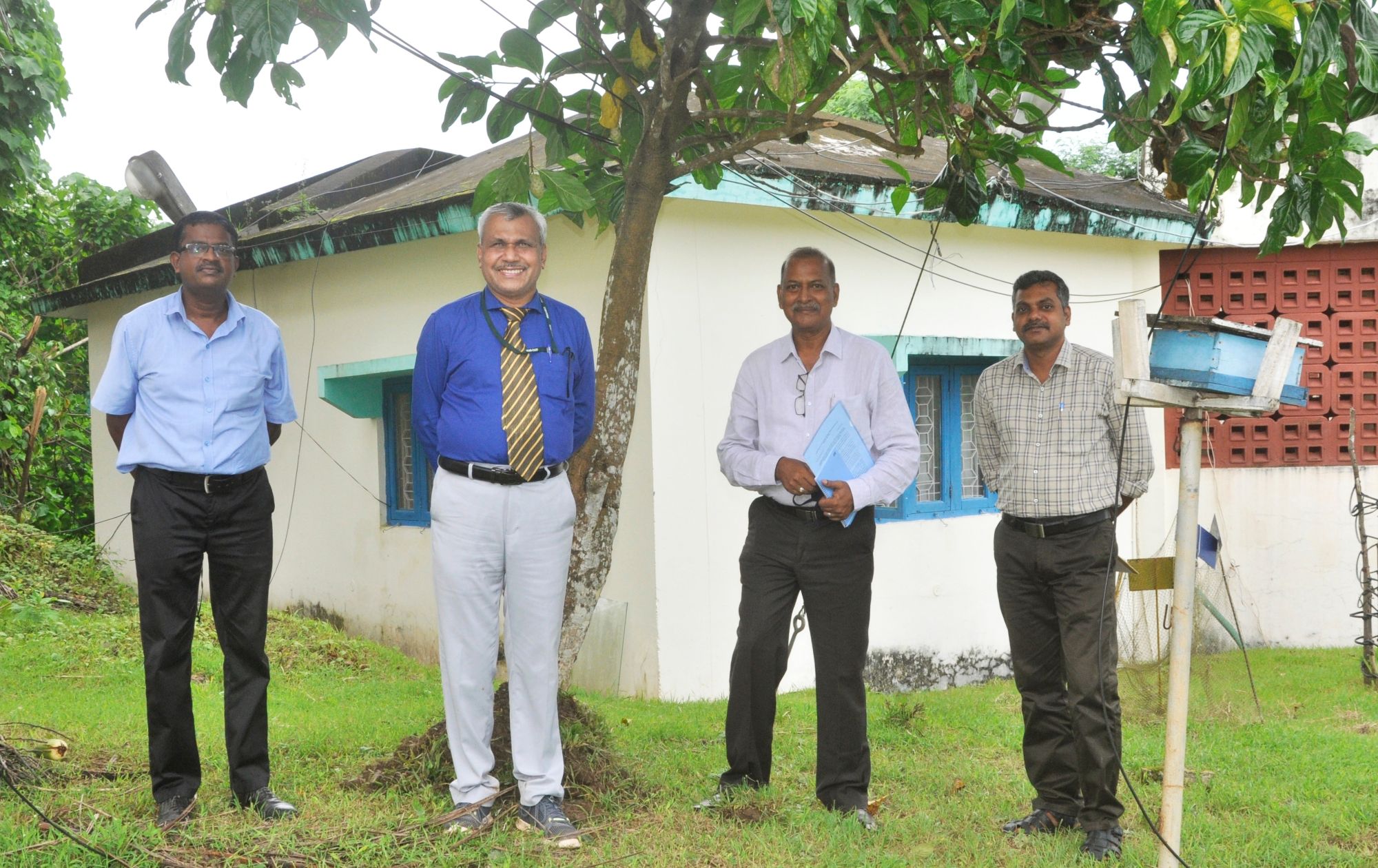
Director, CIARI visiting the Noni plantation at ATIC 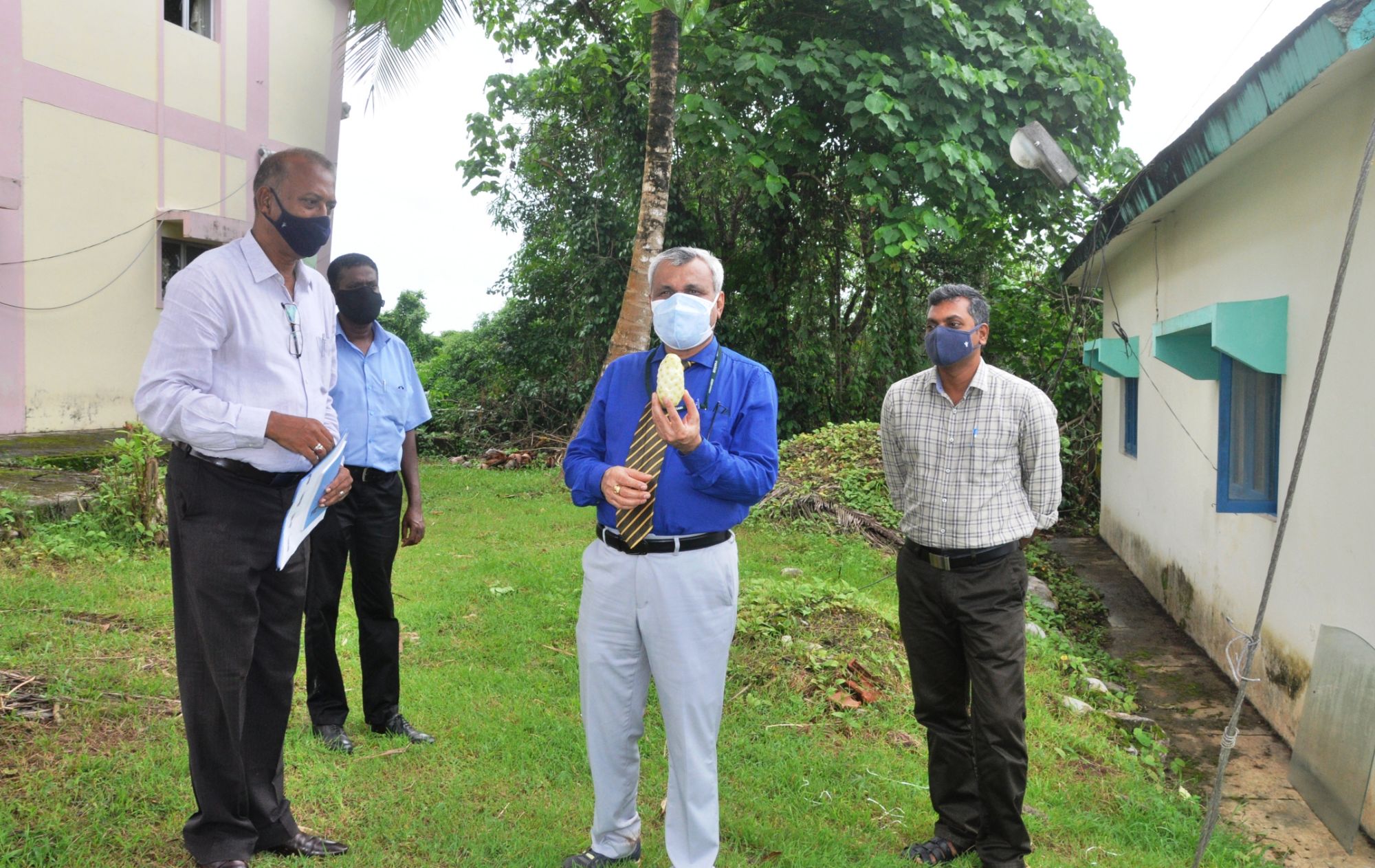
Director, CIARI visiting the Noni plantation at ATIC 
Rice variety CIARI-7 at a farmer’s field in North & Middle Andaman district 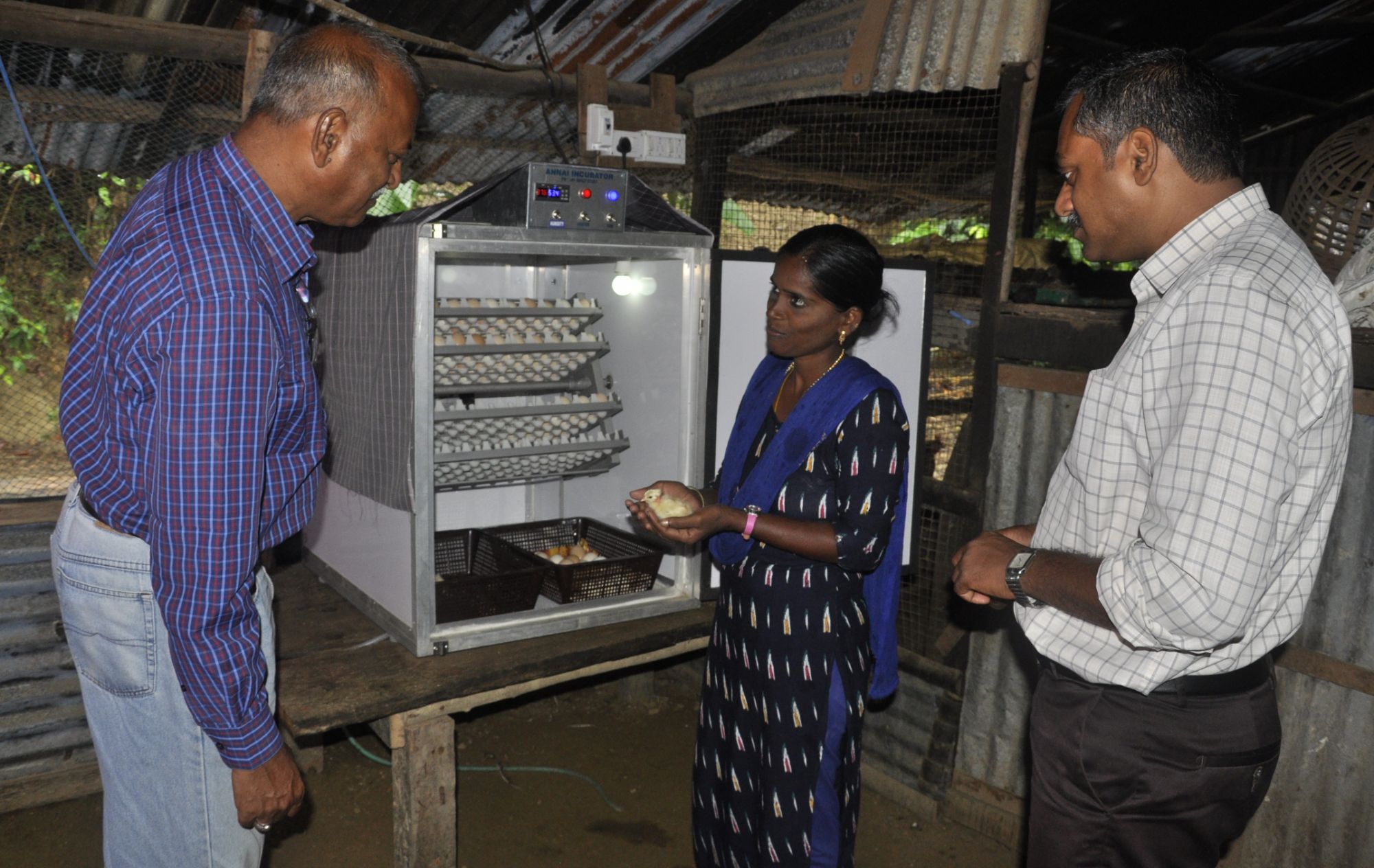
Established mini egg incubator at Indiranagar 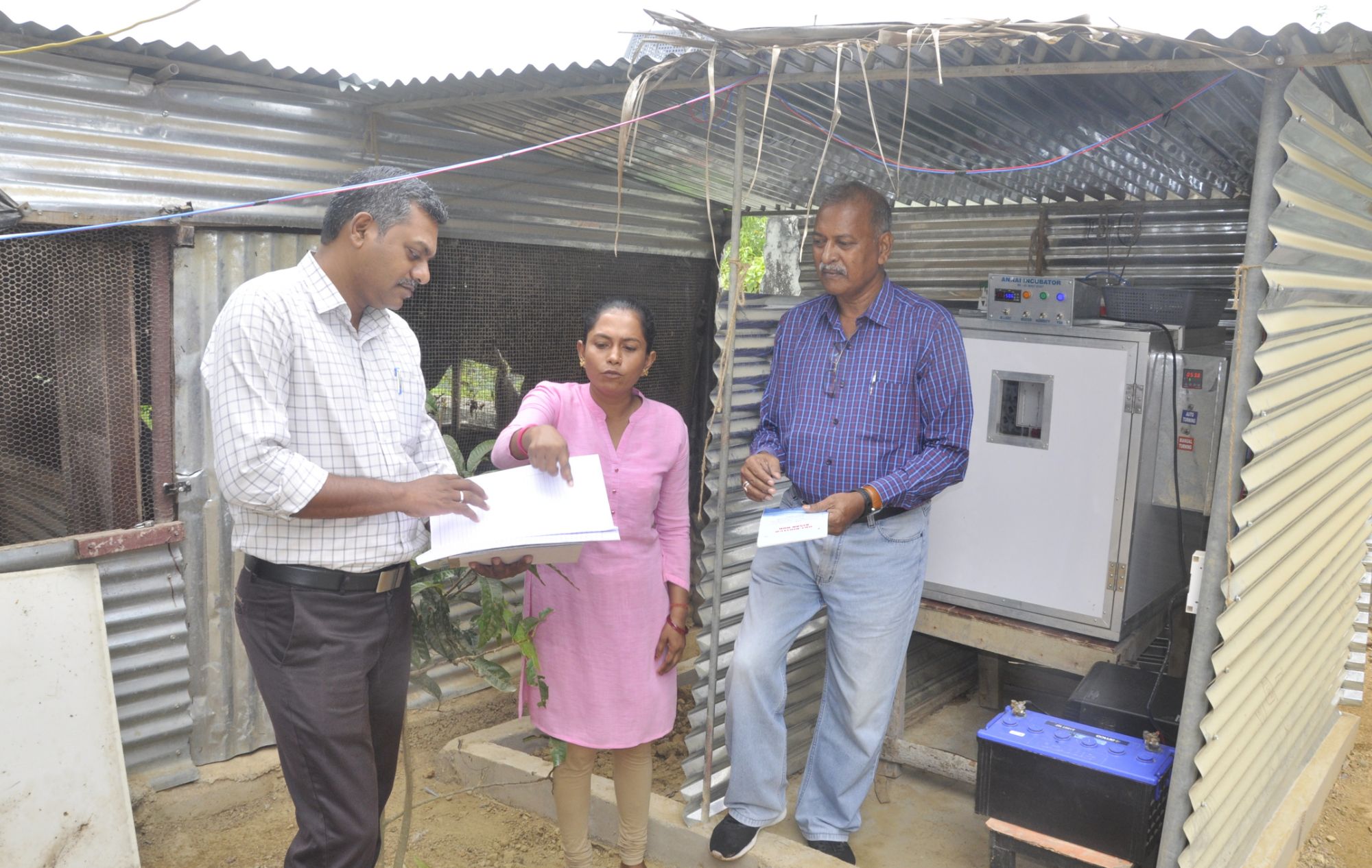
Established mini egg incubator at Nayagaon 
Modified Broad Bed & Furrow System of cultivation for challenged areas 
Before intervention 
After intervention 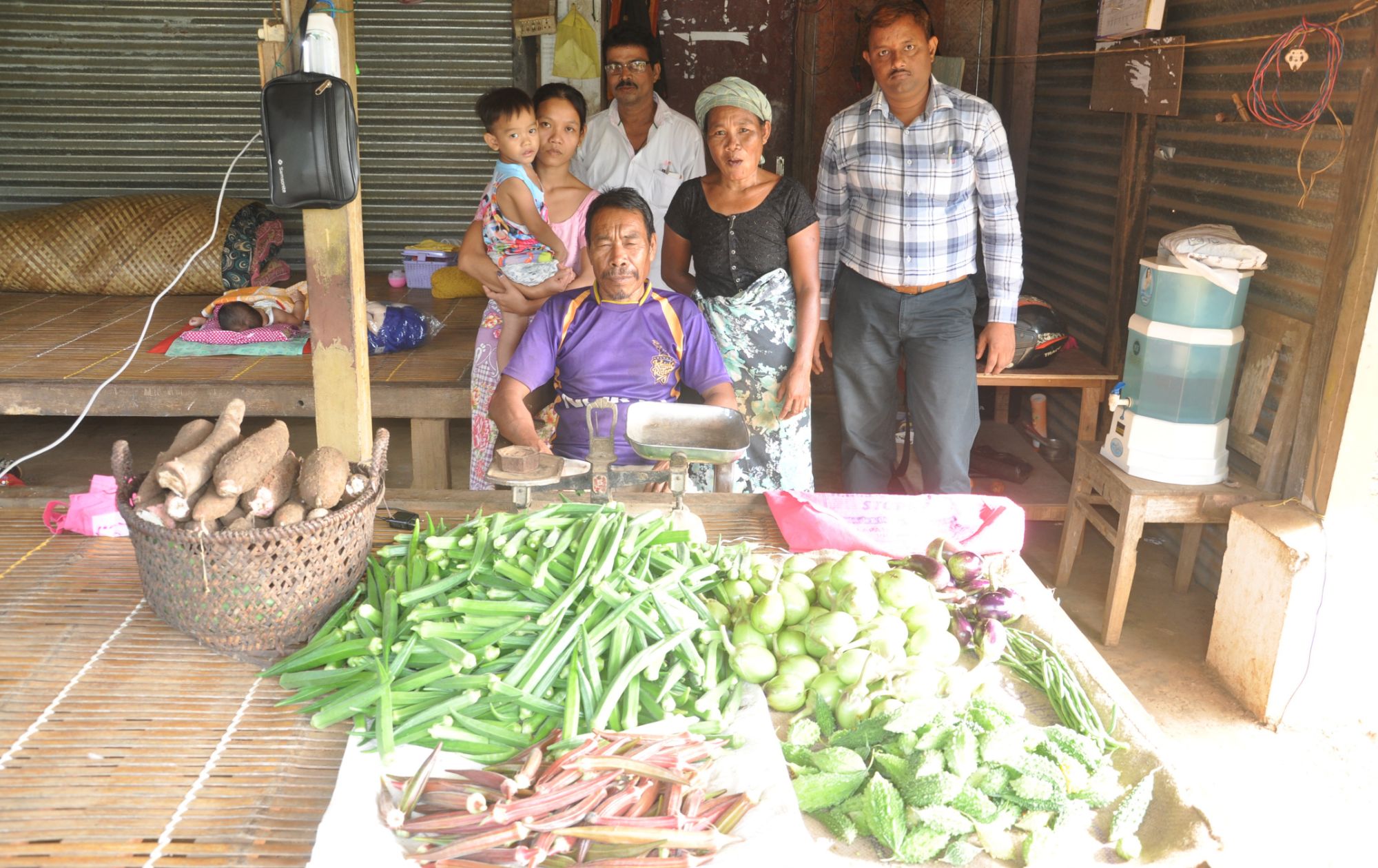
Nicobari farmer with his harvested produce from his farm 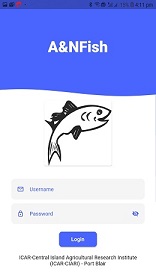
Glimpses of A&N Fish Catch App 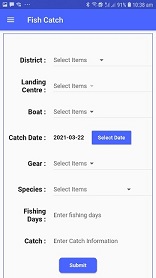
Glimpses of A&N Fish Catch App 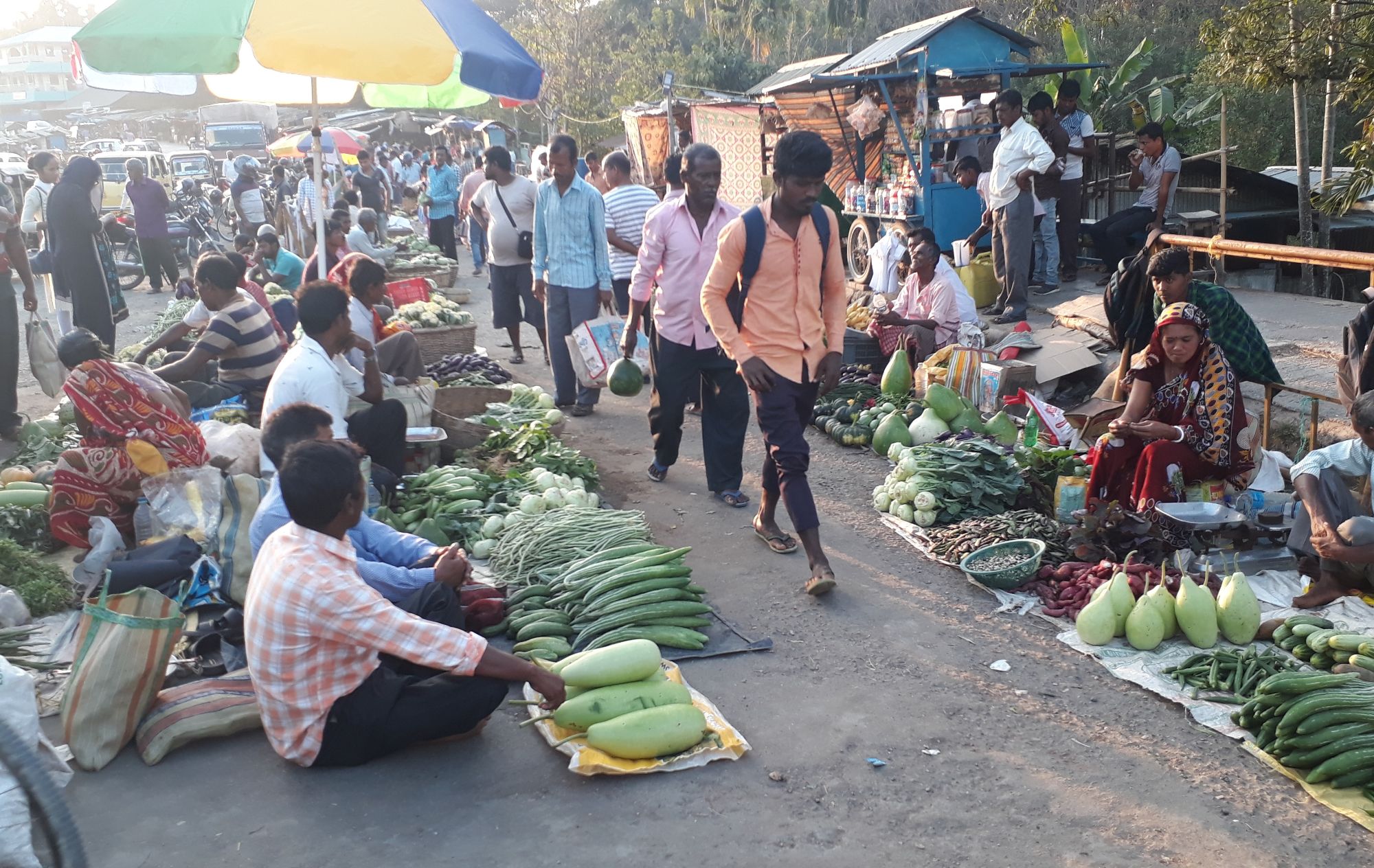
Farmer’s market at Diglipur 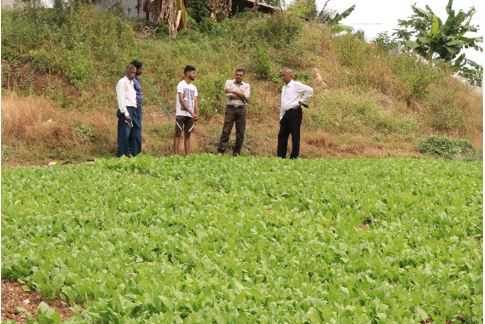
Bhendi var. A-5 
An enterprising farmer Smt. Chellammal of Rangachang village adopted the Bhendi var. A-5 |
|||



